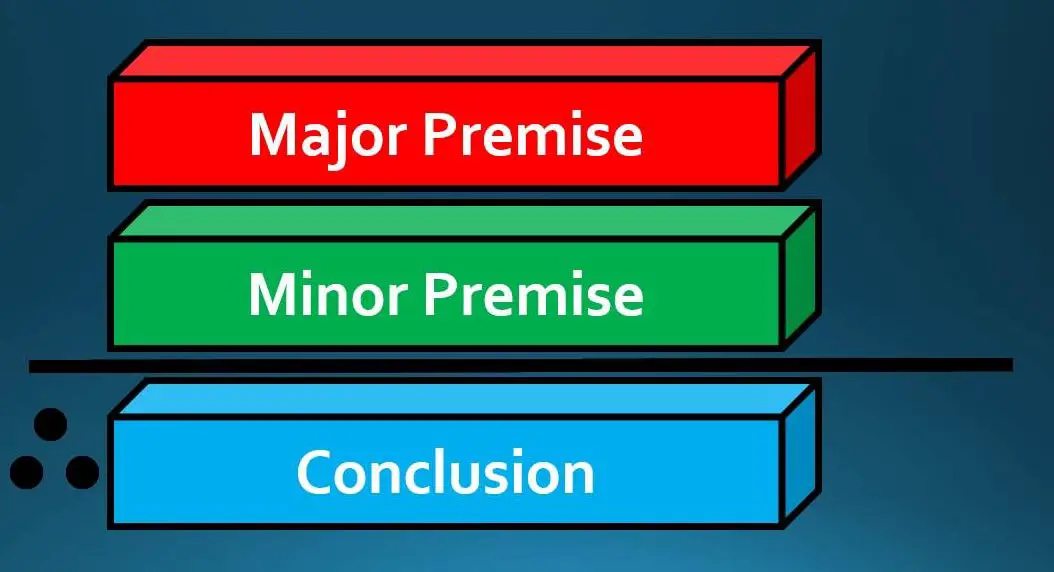Conditional syllogism is a deductive reasoning method that involves two premises and a conclusion. In this method, we use the if-then statements to draw a conclusion. This type of reasoning is commonly used in mathematics, logic, and computer programming.
First, let us explore the basics of conditional syllogism and how it works.
The Basics of Conditional Syllogism
The conditional syllogism is a logical structure that comprises three key components: the major premise, the minor premise, and the conclusion.
The major premise is typically a general statement that follows the if-then format. The minor premise, on the other hand, is a specific statement that stems from the major premise.
Finally, the conclusion represents the logical outcome of both premises put together.
When these premises are combined, they lead to an inevitable conclusion that can be inferred through deductive reasoning.
Therefore, understanding how to construct and interpret conditional syllogisms aids in making sound logical arguments.
Conditional Syllogism Rules
To use a conditional syllogism, we must follow a set of rules.
- First, the major premise has to be a true statement.
- Secondly, the minor premise must be a specific instance of the major premise.
- Finally, the conclusion must logically follow from the two premises.
For instance, if we know that “All cars have tires” and “My bike has tires,” we cannot logically conclude that “My bike is a car” since the major premise does not apply to bicycles.
Examples of Conditional Syllogism
Here are 8 examples of conditional syllogism
Example 1
Major Premise: If you don’t brush your teeth regularly, you’ll get cavities.
Minor Premise: You last brushed your teeth two days ago.
Conclusion: You’re at risk of getting cavities.
Based on what we know about how not brushing your teeth can lead to cavities, and knowing that this person hasn’t been brushing lately, it’s reasonable to conclude that they are at risk for developing cavities.
Example 2
Major premise: All birds have wings.
Minor premise: Penguins are birds.
Conclusion: Therefore, penguins have wings.
Suppose all members of a specific group share a particular characteristic. In that case, when we identify something as belonging to that group, we can conclude that it shares the same features, too. Simply put, this argument says that because all birds have wings and penguins are birds, then penguins must also have wings.
Example 3
Major premise: If you study hard, you will get good grades.
Minor premise: I studied hard for my exam.
Conclusion: Therefore, I will get good grades on my exam.
By deductive reasoning, this argument suggests that studying hard leads to good grades. If someone puts in the effort and time to study for an exam, they will likely do well.
Example 4
Major premise: If it snows, schools may close.
Minor premise: It is currently snowing outside.
Conclusion: Therefore, schools in the area may be closed.
This argument is saying that when it snows, there’s a chance that schools will close as a result. And since it’s currently snowing outside, it is logical to believe that schools in the area might be closed because of the weather.
Example 5
Major premise: All humans need oxygen to survive.
Minor premise: John is a human.
Conclusion: Therefore, John needs oxygen to survive.
This argument is based on the assumption that the major premise is true and applies universally to all humans and that the minor premise accurately identifies John as a member of this group. The conclusion follows logically from these premises and can be considered valid if the premises are accepted as accurate.
Example 6
Major premise: If you eat too much junk food, you will gain weight.
Minor Premise: You eat a lot of junk food every day.
Conclusion: Therefore, you are likely to gain weight.
This statement is something many believe to be true. If you eat unhealthy foods all the time, your body will start to store extra fat, and you will gain weight.
Example 7
Major Premise: All reptiles lay eggs.
Minor Premise: A snake is a reptile.
Conclusion: Therefore, a snake lays eggs.
This statement argues that because all reptiles lay eggs, and snakes are classified as reptiles, then logic dictates that snakes also lay eggs.
Example 8
Major Premise: If you exercise regularly, you will stay healthy.
Minor Premise: I exercise regularly.
Conclusion: Therefore, I am likely to stay healthy.
This argument suggests that exercising regularly can lead to good health. It infers that chances of staying healthy are higher than someone who doesn’t exercise, thus highlighting how our daily activities and habits can impact our overall well-being and encouraging us to prioritize physical activity as part of a healthy lifestyle.
Also Check:
9 Categorical Syllogism Examples
Conclusion
Conditional syllogism is a logical reasoning method that allows us to conclude based on two premises. By following the rules of conditional syllogism, we can avoid logical fallacies and make accurate conclusions.
Each example presents a simple logical argument based on two premises and one conclusion. They demonstrate how reasoning works by using general statements about categories or groups of objects to draw conclusions about specific instances within those categories or groups. This method is widely used in mathematics, logic, and computer programming, and it is a valuable tool for critical thinking.

